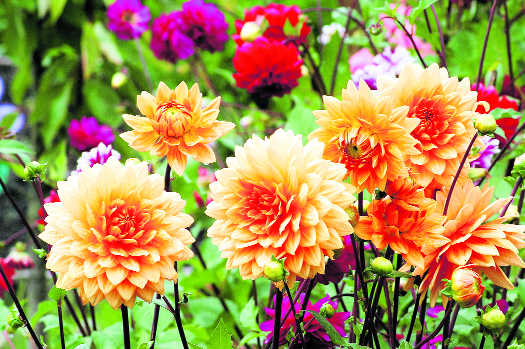Amarjeet Singh Baath
Planting of Chrysanthemum is almost in the last lap and it’s time to think and concentrate on growing Dahlia. Dahlia is among the most admired and favorite winter flowering plant. It is a half hardy, herbaceous, tuberous perennial that bears gorgeous multi-hued flowers. It is grown both for indoor and outdoor elegance. The height of plants varies with variety, so be specific and plan your garden accordingly. Here are some pointers that will come in handy while planning your dahlia display this year
Propagation
Dahlia can be propagated through seeds (annual), division of tubers and cuttings (perennial). However, propagation through seeds yields only single type flowers. The seeds of double types produce both single and mix types. In north India the seeds are sown in the nurseries from mid September to mid October. The seedlings are ready for transplanting within three to four weeks into the flower beds or pots. The flowering time of dahlia is much extended. It begins flowering within 90-100 days of planting by mid January and keeps on flowering till April, provided the spent flowers are removed on a regular basis.
The other method of propagating dahlia is vegetative , which produces progeny true type without variation from the mother stock. In vegetative method ‘division of tuber’ is done if limited plants are required. The tubers are separated from the old clumps with the help of sharp knife with at least one eye attached to the clump in the month of June. The detached tubers cut part is treated with 0.2 % ‘Captan’ (fungicide) to prevent rotting and are then planted deep in the prepared ground.
If the requirement is to have a large no of plants then ‘cutting’ is a very successful method of propagation. The cuttings which are available in most of the nurseries are sourced from other states. The procedure is similar to that for chrysanthemum. In this, the cuttings are taken from the mother stock from the young green shoots. When these are 2-3 inch in length, the shoot is cut with a fine sharp blade. Remove the lower leaves and treat the cut with root-promoting hormone and these are planted five centimeters apart in boxes or pans containing rooting mixture consisting of sand and leaf mould or peat. Keep them in a semi-shaded place and protect from rain.
Pots
Dahlias are also commonly grown as potted plants. The care and concern is almost the same for those planted in flower beds. Plants in pots need more attention than those in ground especially where watering is concerned.
Debudding
Retain the central bud and remove the other buds on the main shoot at ‘pea’ stage. This will give quality bloom. Simultaneously, de-shooting is also done by removing the side shoots arising from the leaf axils. This should be a continuous process.
Staking
As the plant grows in size it becomes tall and heavy, it’s time to stake them. Staking is required to be done for plants in pots as well in the flower beds. If staking is not done properly or with weak support, the stem may give way due to weight of the flower especially when wind blows.
Irrigation
Irrigation in general always depends on the nature of the soil and climatic condition apart from individual plant requirement. It is on need basis rather than a routine garden activity. When the plants are young water intake is more frequent and this changes to deep irrigation at longer intervals for a grown up plant. Ensure proper drainage and it does not accept water logging.
Frost
Dahlia plants are very sensitive to cold, especially frost which kills them. Protect your pots from the frost by shifting them under natural or artificial cover but ensure they receive the required sunlight during day.
Tending tips
It’s an easy-to-grow plant and does well in medium- textured soil. Dahlia requires a sunny location where it can receive 6-8 sunlight hours. If grown under partially shade it will become lanky and weak. While preparing the flower beds add 4- 5 kg of well rotten farm yard manure in one square yard area. Bone meal and potash should be added at the initial stage.
- Avoid using urea frequently which does not do much good to the plant or the quality of flower.
- Top dressing and liquid manure is beneficial during flower formation.
Pinching
Pinching is done when the plant is about 30 cm in height. The growing point is pinched which causes side branches to appear making the plant bushy. However, if only one flower is to be maintained in case of giant varieties, no pinching is required.
Tending tips
- It’s an easy-to-grow plant and does well in medium- textured soil. Dahlia requires a sunny location where it can receive 6-8 sunlight hours. If grown under partially shade it will become lanky and weak. While preparing the flower beds add 4- 5 kg of well rotten farm yard manure in one square yard area. Bone meal and potash should be added at the initial stage.
- Avoid using urea frequently which does not do much good to the plant or the quality of flower.
- Top dressing and liquid manure is beneficial during flower formation.
Pinching
Pinching is done when the plant is about 30 cm in height. The growing point is pinched which causes side branches to appear making the plant bushy. However, if only one flower is to be maintained in case of giant varieties, no pinching is required.
Unlock Exclusive Insights with The Tribune Premium
Take your experience further with Premium access.
Thought-provoking Opinions, Expert Analysis, In-depth Insights and other Member Only Benefits
Already a Member? Sign In Now











